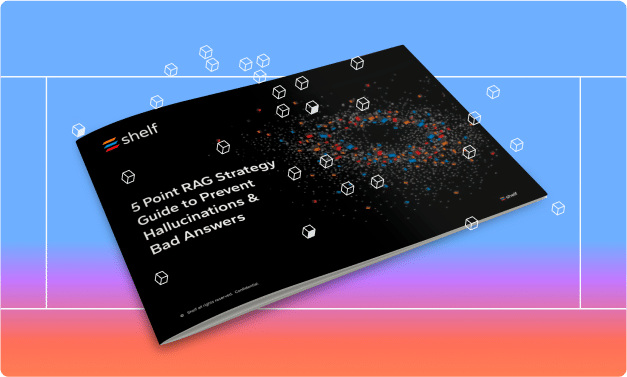Historically, we never cared much about unstructured data. While many organizations captured it, few managed it well or took steps to ensure its quality. Any process used to catalog or analyze unstructured data required too much cumbersome human interaction to be useful (except in rare circumstances) and rarely created much value.
Generative AI changed all of that. Now we have countless opportunities that can put unstructured data to use. New use cases appear every day.
Suddenly, that massive store of unstructured data is significant. It’s growing faster than ever, as well. IDC estimates that unstructured data makes up 90% of the total data created.
Thanks to GenAI, what was once an underutilized asset is now a critical component of innovative, creative, and analytical applications. In fact, organizations that aren’t making aggressive use of their unstructured data are putting themselves at a disadvantage.
3 Ways GenAI Makes Unstructured Data More Important Than Ever
Generative AI is obviously a powerful tool, but why does it synergize with unstructured data so well, as opposed to structured data? Structured data is certainly valuable, and it will never be replaced, but unstructured data offers some unique benefits for GenAI that capitalizes well.
First, let’s get a clear understanding of unstructured data. Unstructured data refers to information that does not have a predefined data model or schema. This content is not typically organized in a systematic manner and requires advanced tools for processing and analysis.
Here are some examples of unstructured data that you’re likely to come across.
- Natural Language Text: Includes customer reviews, support tickets, product documentation, regulatory documents, emails, PDFs, and other documents.
- Multimedia Data: Photos, graphics, sound recordings, podcasts, and video files.
- Social Media Content: Includes tweets, posts, comments, reviews, and other user-created data.
- Sensor and IoT Data: Data from sensors in smart devices, wearables, and industrial machines.
- User-Generated Content: Encompasses blogs, forums, and customer feedback.
- Biometric Data: Includes fingerprints, facial recognition data, and DNA sequences.
Now let’s explore three key ways generative AI has made unstructured data accessible, valuable, and an important tool in our decision-making processes.
1. Generative AI Models are Trained on Unstructured Data
Generative AI models, such as GPT-4, rely heavily on unstructured data for training. Like we mentioned, unstructured data is the majority of data created these days, which includes text, images, audio, and video that do not have a predefined data model or schema.
This means that unstructured data is the primary data source we use to train generative AI models. It enables us to train AI models to perform more sophisticated tasks, thereby enhancing their value and applicability in real-world scenarios.
Unstructured data is crucial for generative AI for three key reasons:
Rich Information Source
Unstructured data contains vast amounts of information, making it a rich source for training AI models. Text documents, social media posts, and multimedia files provide diverse inputs that enhance the model’s language understanding and capabilities.
This variety ensures that the model is exposed to a wide range of topics, language styles, and formats, making it more versatile and robust.
Contextual Understanding
AI models learn context and nuance from unstructured data. This data type allows models to grasp complex language patterns, cultural references, and intricate details that structured data cannot convey.
For instance, the subtleties of human language, such as sarcasm, humor, and idiomatic expressions, are embedded in unstructured data. This understanding is crucial for generating coherent and contextually appropriate responses.
Data Diversity
Generative AI applications, such as content creation, customer support, and personalization, benefit from the variety of unstructured data. The model’s ability to generate human-like responses and content depends on the extensive and varied training data.
Whether it’s drafting articles, composing music, or generating dialogue for virtual assistants, the richness of unstructured data enables AI to produce high-quality outputs across different domains.
2. In Enterprise Applications Generative AI Models Interact with Organizations’ Unstructured Data
In production environments Generative AI models must usually interact with organization’s unstructured data to deliver meaningful and relevant outputs.
For instance, a RAG AI assistant will rely on query relevant knowledge snippets to generate contextualized and knowledge grounded responses. Knowledge bases feeding RAG systems contain unstructured data such as text, images and videos. The quality of such data is paramount to successful GenAI implementations.
Here’s why this interaction is so important:
RAG Knowledge Bases
Organizations use unstructured data as the foundational knowledge base for grounding GenAI responses through RAG. This approach enhances the relevance of AI in performing enterprise-specific tasks and reduces instances of hallucinations. However, the accuracy of the AI-generated responses now heavily depends on the quality of the unstructured data used to construct the knowledge base. If the underlying data is inaccurate, the generated responses will also be inaccurate.
Real-Time Data Processing
Many generative AI applications, such as chatbots and virtual assistants, require real-time interaction with unstructured data. Processing and analyzing unstructured data on-the-fly allows these models to respond quickly and accurately to user inputs, enhancing user experience and satisfaction.
Personalization and Customization
To provide personalized and customized experiences, generative AI models need to analyze and interpret unstructured data, such as user preferences, feedback, and historical interactions. This interaction allows the AI to tailor responses and recommendations to individual users.
Data Enrichment and Contextualization
Unstructured data often provides additional context that enriches structured data. For instance, customer service transcripts can add valuable context to customer profiles stored in structured databases. Generative AI models that interact with this enriched data can offer more comprehensive solutions and insights.
Feedback Loop for Continuous Improvement
Interacting with unstructured data creates a feedback loop that helps improve AI models over time. By analyzing the unstructured data generated through interactions, you can identify patterns, trends, and areas for improvement. This continuous learning process ensures that the models evolve and adapt to changing user needs and contexts.
3. Generative AI Models Generate Unstructured Data (Mostly)
Generative AI models primarily produce unstructured data. The proliferation of this unstructured output further increases the amount of unstructured data organizations will use to train models and produce insights. The “unstructured data loop” underscores the importance of managing and utilizing it effectively for several reasons:
Increased Volume of Data
As generative AI models generate vast amounts of unstructured data, the volume of this type of data within organizations significantly increases. This surge requires advanced solutions for storing and organizing unstructured data, making it a critical focus for businesses aiming to harness AI effectively.
Enhanced Analytical Opportunities
The unstructured data generated by AI models presents rich opportunities for analysis. By analyzing the newly created unstructured data, you can gain deeper insights into customer preferences, market trends, and operational efficiencies. Advanced analytical tools and techniques are required to process and interpret this data.
Training and Fine-Tuning Models
The unstructured data produced by generative AI models can be used to train and fine-tune these models. This iterative process improves the models’ accuracy and relevance, ensuring they remain effective in various applications. The continuous generation and refinement of unstructured data make it a vital resource.
Data Integration Challenges
With the increasing volume of unstructured data generated by AI, integrating this data with existing structured data systems becomes more complex. Organizations need sophisticated data management strategies to ensure seamless integration and usability. This integration is crucial for creating a unified view of data, which is essential for making informed business decisions.

Quality Input for Quality Output
While unstructured data is invaluable for training and enhancing AI models, it’s not without challenges. The quality of your output is dependent on the quality of your input. As they say, “Garbage in, garbage out.”
It’s critical, therefore, that you take deliberate steps to ensure the quality of the data that trains and feeds your generative AI models. This is not a one-off task, but a continuous process that should be performed on the data you collect as well as the unstructured data you generate.
What does poor quality data look like? It’s different for every organization, so you’ll have to define it carefully for yourself, but the major challenges fall into the following categories:
Inaccurate Data: Inaccurate data can lead to misleading insights and poor decision-making. It often requires extensive cleaning and validation to ensure reliability.
Outdated Data: Outdated data can render analyses irrelevant or incorrect, as it does not reflect current conditions or trends. Regular updates and maintenance are necessary to keep data current.
Inconsistent Data: Inconsistent data can arise from varied formats and sources, making it difficult to integrate and analyze. Standardization is essential to achieve consistency.
Incomplete Data: Incomplete data lacks critical information, which can skew analyses and models. Filling in the gaps or identifying missing data points is crucial for accuracy.
Data Without Context: Data without context can be ambiguous and hard to interpret. Providing contextual information is key to deriving meaningful insights.
Duplicate Data: Duplicate data can inflate datasets and lead to redundant or skewed results. Identifying and removing duplicates ensures data integrity.
Noncompliant Data: Noncompliant data may violate privacy laws or industry regulations, posing legal risks. Ensuring compliance through stringent data governance practices is essential.
As you can imagine, errors like those can have a profound impact on the quality of your generative AI outputs. Managing your unstructured data is crucial for leveraging its full potential.
This means you need comprehensive solutions for analyzing, storing, refining, and utilizing this data. Proper management of unstructured data ensures that generative AI can deliver consistent value and drive innovation in your organization.

Other Considerations for Unstructured Data
As you work with unstructured data, it’s important to understand and address several important considerations to ensure effective utilization and management. Each of these concepts play a crucial role in maximizing the performance of your generative AI applications and the value of unstructured data.
Privacy and Security
Unstructured data frequently contains sensitive and personal information, which raises privacy and security concerns. Organizations must implement data protection measures to safeguard against unauthorized access and data breaches. Compliance with data privacy regulations, such as GDPR and CCPA, is also crucial.
Storage and Management
The sheer volume of unstructured data can overwhelm traditional storage systems. Storing, managing, and retrieving this data requires scalable and efficient solutions, such as data lakes and cloud-based storage systems.
Complexity in Analysis
Analyzing unstructured data is inherently more complex than analyzing structured data. Advanced tools and techniques, such as natural language processing (NLP), machine learning, and image recognition, are necessary to extract meaningful insights. These technologies require specialized skills and significant computational resources.
Integration with Structured Data
Integrating unstructured data with existing structured data systems can be challenging. Creating a unified view of all data types necessitates sophisticated data integration strategies and technologies. Without proper integration, organizations may struggle to leverage the full potential of their data assets.
Bias and Fairness
Unstructured data can inadvertently introduce bias into AI models. Bias in training data can lead to unfair or discriminatory outcomes. It is essential to implement techniques for identifying and mitigating bias in unstructured data to ensure fair and equitable AI solutions.
Interpretability and Transparency
The complexity of unstructured data can make AI models less interpretable and transparent. Understanding how models process and make decisions based on unstructured data is critical for building trust and accountability. Organizations must prioritize explainability and transparency in their AI systems.
The Full Potential of GenAI
In the era of generative AI, unstructured data has evolved from an underutilized asset to a cornerstone of innovation and competitive advantage. The vast, rich, and diverse nature of unstructured data makes it indispensable for training, refining, and deploying AI models that drive meaningful insights and personalized experiences.
As you harness the power of unstructured data, be sure to address the quality of your input data. By doing so, you position your organization to fully leverage the transformative potential of generative AI, turning unstructured data into a powerful tool for growth and success.




